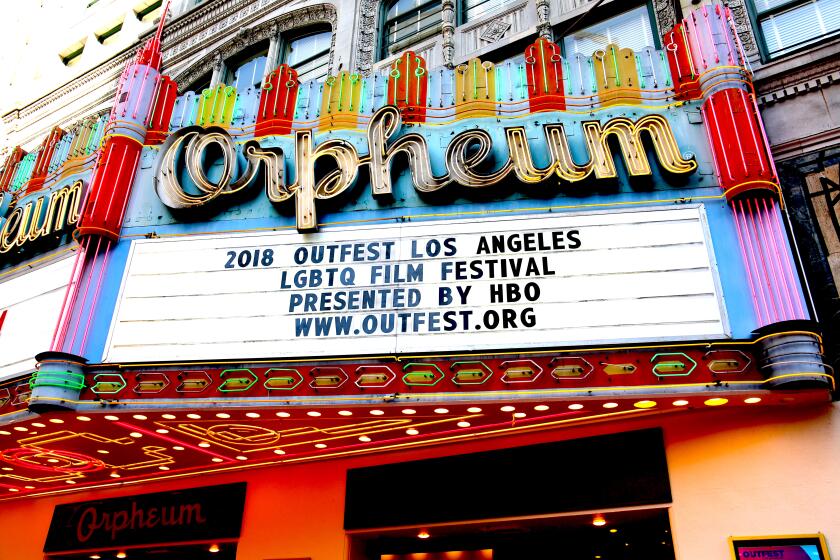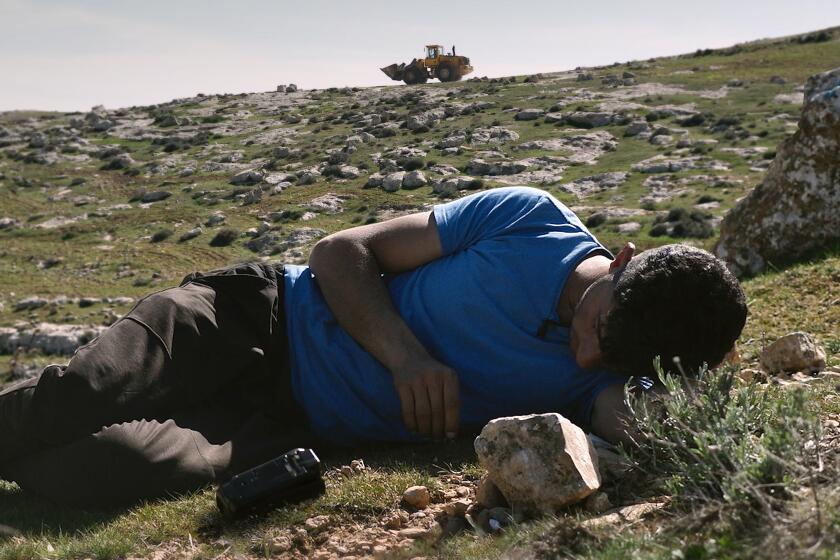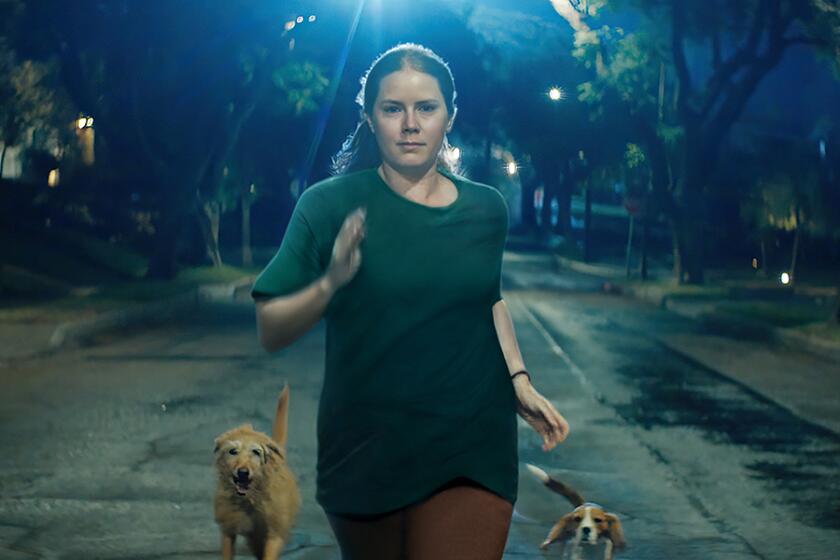Harmony Korine explains the ‘vibes’ and ‘vapors’ of his hallucinatory ‘Aggro Dr1ft’

- Share via
TORONTO, Can. — Few recent movies inspire the question “What am I looking at?” quite as strongly as Harmony Korine’s new “Aggro Dr1ft.” Filmed with thermal-vision cameras and undergoing extensive post-production work involving both visual effects and artificial intelligence, the movie follows a Miami hitman (Jordi Molla) as he alternates between a quietly loving life at home with his wife and family and the brutal realities of his job. But that story is told with a looping, repetitive style and otherworldly visuals that can cause viewers to zone out and drift away. (Or worse: Fainting and nausea were reported at some screenings.)
Maybe don’t call it a movie at all. Along with premiering “Aggro Dr1ft” at film festivals in Venice, Toronto and New York, Korine has been announcing his new Miami-based company, EDGLRD, a multidisciplinary, multimedia outfit that will be involved in a wide range of creative endeavors. (That it’s even called “Edgelord” may or may not be a joke upon the very people it’s intended to appeal to.)
The technology involved in creating “Aggro Dr1ft” allows it to be constantly updated and altered, so the version that screens at the upcoming New York Film Festival will have some different images than what has already screened at Venice and Toronto.
Korine, still boyish at age 50, even as his hair is more gray than not, burst upon the ’90s filmmaking scene as the screenwriter of the controversial “Kids” and then as the director of “Gummo” and “Julien Donkey-Boy.” After some years away and a reset, he returned with a bracing run of unpredictable, inventive features that challenged audiences and pushed cultural boundaries: “Mister Lonely,” “Trash Humpers,” the commercial breakthrough of “Spring Breakers” and “The Beach Bum.”
Korine has always had a hand in other creative endeavors, which coalesce into something of a unified worldview that mixes an outsider’s love of pop culture, prankish humor and thoughtful artistic explorations. An exhibition of paintings by Korine inspired by the thermal imagery of “Aggro Dr1ft” will be on display at L.A.’s Hauser & Wirth gallery from Sept 15 through Jan. 14.
As a photographer, he has shot campaigns for clients such as Gucci and Kim Kardashian’s Skims swimwear line, the latter of which featured the reality star-entrepreneur amid bikini-clad models with space alien heads.
Rapper Travis Scott also appears in “Aggro Dr1ft,” and Korine recently directed segments of Scott’s “Circus Maximus” project, including performance footage at the ancient amphitheater of Pompeii, alongside other filmmakers such as Gaspar Noé and Nicolas Winding Refn.
When “Aggro Dr1ft” premiered at the Venice Film Festival, Korine and his EDGLRD collaborators did their press conference wearing 3-D-printed masks inspired by the creature effects in the movie. Korine walked the red carpet with his wife, Rachel Korine, and the oldest of their three children, 14-year-old Lefty Korine.
“She was like, what the f— is this?” Korine said with the confused wonder of the typical parent of a teenager. “I don’t even know if she’d ever seen any of my movies before.”
After the midnight Toronto screening of “Aggro Dr1ft,” Korine came out in another of the 3-D-printed masks for the Q&A, working the room like a talented showman and leaving the dazed audience equal parts delighted and bewildered.
The afternoon before the film played in Toronto, Korine sat for an interview along with Eric Kohn, who recently left his position as vice president of editorial strategy and executive editor at IndieWire to become head of film strategy and development at EDGLRD, and visual-effects artist Joao Rosa, the new company’s creative director.
The future of “Aggro Dr1ft” is still being determined, as to whether it will be released to theaters or launched online via a streaming platform.
“We really were even unsure about putting it in a movie context,” Korine said about premiering the “Aggro Dr1ft” project at festivals. “We’re trying to make something that was more immersive and that felt closer to an experience — a kind of a specific vibration that was more physical.”
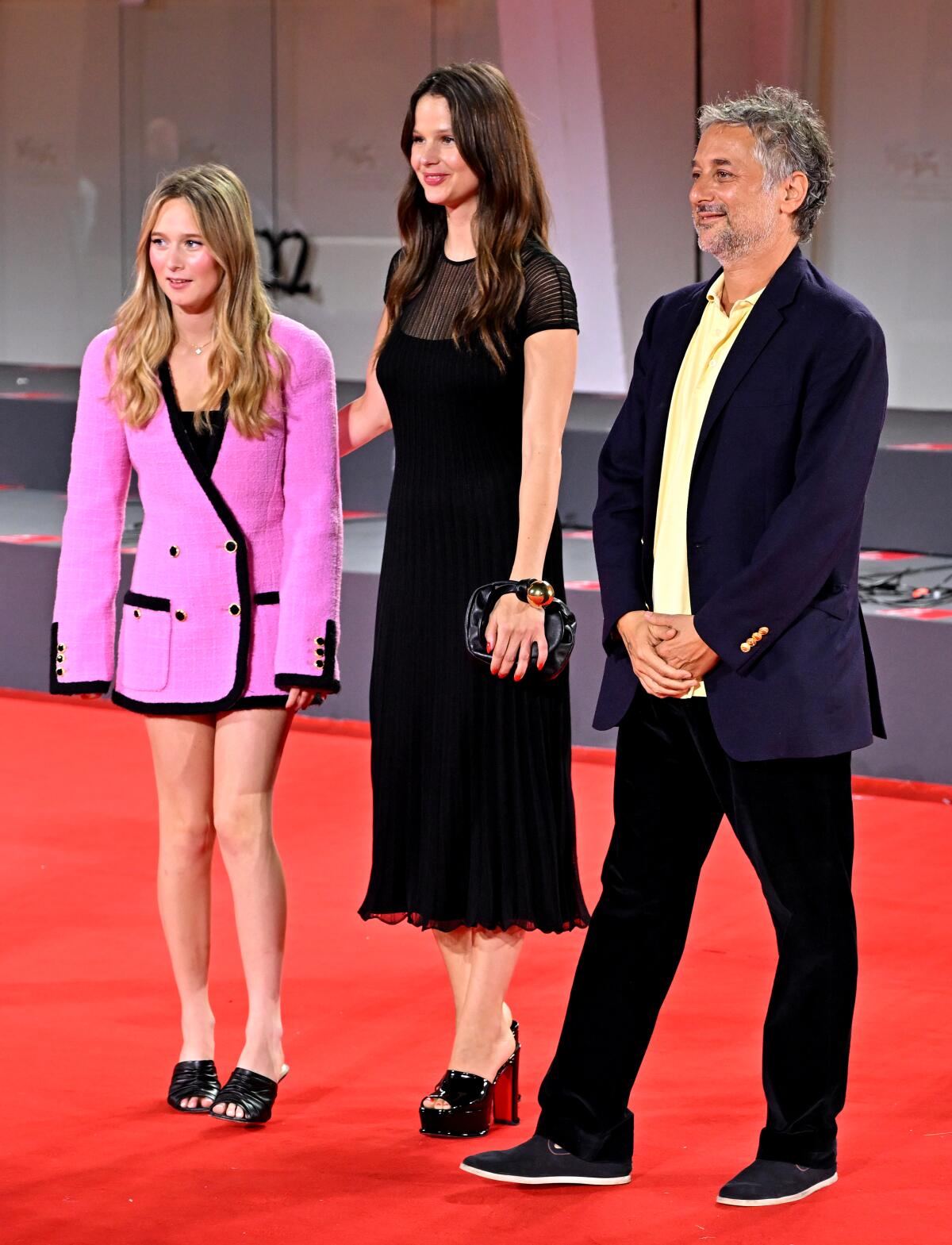
So if “Aggro Dr1ft” isn’t a movie, what is it? What do you refer to it as?
HARMONY KORINE: I guess it works in a lot of ways like film, but it’s its own thing. We’re trying to make things that were very much of the culture and very much indebted to gaming or alternative forms that were out there. A couple years ago, we started losing a lot of interest in conventional linear filmmaking and started spending more time on games. I was starting to feel like there was a kind of singularity where a lot of art and gaming were all starting to merge into something that was maybe difficult to articulate. I mean, we’ve been calling them “blinx,” because I feel like that’s just a random kind of connotation. But they’re their own thing. They’re their own kind of new form.
ERIC KOHN: I think it’s worth pointing out that we’ve been living in a media climate that’s very open to work that consolidates from many different media at once. And people have been grasping for the right term to describe that for a long time. Remember when “transmedia” was a thing? “Convergence culture?” This kind of work is a direct reflection of that impulse to create something that has all these different kinds of touch points. Like, it can be a game, it can be fashion, it can have all these different forms. The feature film is just one piece of this larger pie. So I think that’s really what the EDGLRD concept is extrapolating in.
Beyond “Aggro Dr1ft,” what will EDGLRD be creating?
KORINE: The way it’s set up is closer to a design company. There’s also a large tech element. We’re creating our own tech for purposes of our own creation and IP. Basically seeing what we can make, how far you can push the medium. And then, at the same time, it’s also really at its core just a way of trying to have fun again with all this stuff. We’ll be making anything — from filters to features and games — and creating our own platform. It’s a way to circumvent a lot of the traditional system.
KOHN: And also just speeding up the process of experimentation. The hardest aspect of the development process in the traditional feature-film space is time. Because you have great filmmakers who just can’t get something off the ground and they get frustrated, [Korine] included, and then they move on because it’s just not happening. In this situation, we can bring people in, show them the kinds of tools that we‘re developing and get them instantly to start innovating ideas. It’s totally different from the way the system usually works.
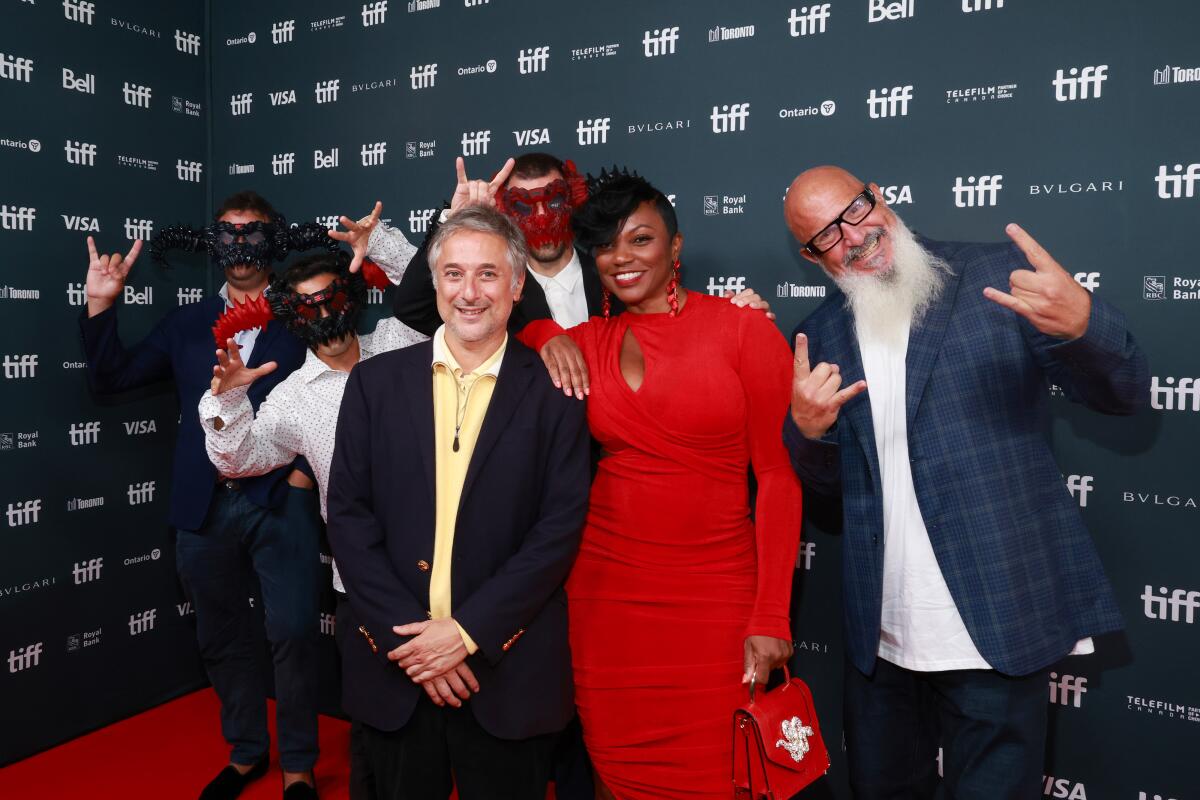
With “Aggro Dr1ft,” what are we seeing specifically? Were the core images captured with thermal cameras?
KORINE: Yes and no. At the base, the look is thermal. So we got a lot of cameras from NASA, but it wasn’t really just thermal. It was all filtered through a lot of intensive post work that included everything from VFX [visual effects] to AI [artificial intelligence] and everything in between.
Where does AI enter? What is the function of AI in the project?
KORINE: It’s just another layer. It was just part of the visual language.
JOAO ROSA: AI is starting to permeate all the aspects of the company, because we are very focused on developing technology. And AI is becoming mixed with everything, with programming, with the storytelling. There’s many ways we can leverage AI. So the first experimentation was “Aggro Dr1ft,” and it was purely visual. Like Harmony saying it was this additional layer, because “Aggro Dr1ft” has so many layers. It wasn’t just a thermal capturing. There were more ways we captured than just thermal. And then in the process of crafting it, we had the thermal, the VFX, the AI. So it’s a visual thing.
So many people are scared and upset about AI. What’s making you want to embrace it?
KORINE: The way we’re using it, it’s not really the existentialist threat. It’s a new creative tool.
ROSA: I come from this world of VFX animation, so it’s really my community that is completely afraid of the repercussions of AI. So I know exactly the different ways AI can be used. The first, initial fear of people being replaced by it, if you use it in a certain context — for us, it was used to achieve things that wouldn’t be possible otherwise. Which I think is the exciting part of AI and the part that Harmony also gets super-intrigued by. So it is really achieving things that we wouldn’t achieve otherwise.
KOHN: I think, actually, Hollywood is super-excited about the potential of the tool, but also afraid to offend anyone who feels some inherent fear associated with the unknown. There’s this new thing we don’t totally understand what it’s going to do to us and society, but most people are kind of getting that it’s here and it’s going to have an impact, and that’s just going to be part of how we work. So let’s work with it and do something constructive with it.
KORINE: And in the end, it either works or it doesn’t work. It has to have its own merit in order to survive, just like anything else.
From what I had already read before I saw it, I expected to feel a lot more alienated from “Aggro Dr1ft.” I was surprised by how much story there was and how emotional I found it. It’s about this guy who goes out into the world to work but wants to get back to his family. Harmony, is that where you are now?
KORINE: That’s something that people can identify with on a very base level. I don’t know about myself, but in the context of the story, I think he’s a character who is blessed with a gift. The gift is really also his curse. And so the story itself is very dystopian, culturally. Everything has been boiled down to its most primal. It’s all assassins, it’s all hit men, this kind of tropical noir. And I think in his heart, as a character, he is almost religious. If you listen to what he says in the end, “All we have is the love of our children and the love of God,” because he knows everything that he does is destructive. But he’s in some ways redemptive.
As much as the project has to do with EDGLRD and the technology used to make it, it still sounds personal for you.
KORINE: In the end, all the tech conversation is really just in service of the story. At its core, you want to be moved or you want to feel something. It’s a journey and a narrative that hopefully you feel.
When you did “Spring Breakers” and “The Beach Bum,” you spoke about this fluid editing style you called “liquid narrative.” Is this an extension of that?
KORINE: It’s a glitch world. It’s like a looping glitch world. It’s caught between reality and something hyper real. That’s why we’re using the thermal imagery. I liked the idea of something being heat-based, of it kind of attaching itself to the soul of the character. And so it really then becomes about the silhouettes, the colors, the heat, the life. And there is something kind of beautiful about that experience. It is an attempt to show a kind of post-articulation: what comes beyond just a simple articulation and an explanation of the narrative.
And it’s closer to a feeling or a vibration. That’s why vibes are, in films and art and games right now, for me, the most essential. I don’t even know what has meaning anymore. Are we living in a time that’s post-meaning? And so then what are we left with? We’re left with the vapors. And so this is an attempt to step inside the film.
Do you ever see yourself making a conventional movie again?
KORINE: That’s hard. Who knows? This is so much more exciting. It really is the potential to create worlds and feelings, and there’s so much potential. Right now, I’ve never been this excited about creating, ever. Because it’s limitless in a lot of ways. That’s the most difficult part — when you can create anything, then what do you do?
More to Read
Only good movies
Get the Indie Focus newsletter, Mark Olsen's weekly guide to the world of cinema.
You may occasionally receive promotional content from the Los Angeles Times.




